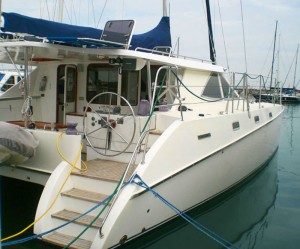Gov’t pins hopes on revival of manufacturing

A Philippine-made catamaran sailing yacht made by Ces Craft Philippines. The Aquino administration is confident that a solid foundation is being laid for the Philippines to rebuild its manufacturing industry and retake its position as one of Southeast Asia’s leading exporters. PHOTO FROM BOATSHOPMANILA.COM
The Aquino administration is confident that a solid foundation is being laid for the Philippines to rebuild its manufacturing industry and retake its position as one of Southeast Asia’s leading exporters.
The revival of the country’s manufacturing sector will allow the economy to experience the kind of growth that leads to more jobs and higher income levels, Socioeconomic Planning Secretary Arsenio Balisacan said.
The country’s healthy growth in the past three years, driven largely by remittances that fuel domestic demand, has helped improve the Philippines’ image from one that is marked by mere booms and busts.
“We can still get back our manufacturing industry,” Balisacan said during an interview with Inquirer editors and reporters.
The country will need a favorable investment climate if it hopes to “sustain confidence in the economy,” he added.
In line with that goal, he said, the administration plans to further boost its infrastructure development program to address major bottlenecks, particularly in the transportation and energy sectors.
“If there is any single factor that investors are looking at, not just foreign but even our own domestic investors, it’s the quality of our infrastructure and backlogs of all kinds, from power to transportation, from airports to piers,” Balisacan said.
The government plans to raise infrastructure spending to 20 percent of the national budget by next year from this year’s 16 percent. By 2016, President Aquino’s last year in office, spending may stand at 25 percent of the national budget, the equivalent of roughly 5 percent of gross domestic product.
Also, officials are working to speed up the rollout of various big-ticket projects under the administration’s public-private partnership (PPP) scheme, where the bulk of the money to be spent will come from the private sector, he said.
“Admittedly, we have overestimated the speed by which one could move PPP projects,” he said, citing procurement hurdles that most Cabinet officials had not foreseen when the PPP promises were first made.
The administration, he said, has admitted that most PPP projects may not be completed by 2016.
“But the President does not really care who inaugurates these projects,” he said, noting that the construction of new roads and train lines has already started.
In the past three decades, the Philippines suffered from misguided policies and mismanagement that led to the decline of the manufacturing sector—the industry that generates the most jobs, Balisacan said.
The failure of past administrations to develop the country’s infrastructure aggravated energy problems and created logistics bottlenecks that choked production, he said.
As a result, the service sector and domestic consumption, supported by remittances from migrant workers, have become the country’s main growth drivers.
Balisacan said that, while this has been a welcome phenomenon, the country still needs to build up manufacturing, which has the potential to create better-paying jobs and more stable employment, enabling more people to rise out of poverty.














